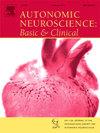Novel role for purinergic 2× subtype 4 (P2X4) receptors in the exercise pressor reflex and mechanoreflex: Effect of heart failure
IF 3.3
4区 医学
Q2 NEUROSCIENCES
引用次数: 0
Abstract
We investigated the role played by ATP-sensitive purinergic 2 × 4 (P2X4) receptors on the sensory endings of thin fibre muscle afferents in exercise pressor reflex and mechanoreflex activation in healthy/SHAM rats and rats with heart failure with reduced ejection fraction (HF-rEF). We hypothesized that infusion of the P2X4 receptor antagonist 5-BDBD (8 μg) into the hindlimb arterial supply would reduce the mean arterial pressure (MAP) and renal sympathetic nerve activity (RSNA) responses to 30s of electrically-induced hindlimb skeletal muscle contraction (model of exercise pressor reflex activation) and 30s of hindlimb skeletal muscle stretch (model of mechanoreflex activation) in decerebrate, unanesthetized HF-rEF rats but not SHAM rats. Ejection fraction was significantly lower in HF-rEF (46 ± 3 %) compared to SHAM (83 ± 2 %; P < 0.001) rats. In SHAM rats, P2X4 receptor blockade had no effect on the pressor response to hindlimb muscle contraction (n = 8) or the pressor and RSNA response to muscle stretch (n = 4). However, in SHAM rats we found that P2X4 receptor blockade significantly reduced the RSNA response to muscle contraction. In HF-rEF rats, P2X4 receptor blockade reduced the pressor and RSNA response to hindlimb muscle contraction (n = 7) as well as the pressor, but not the RNSA, response to hindlimb muscle stretch (n = 8). Collectively, the data suggest that P2X4 receptors on thin fibre muscle afferent sensory endings play a role in the evoking the exercise pressor reflex in healthy subjects that is limited to RSNA, and that in HF-rEF this expands to a significant role in mechanoreflex and exercise pressor reflex-mediated blood pressure control.
嘌呤能 2× 亚型 4 (P2X4) 受体在运动加压反射和机械反射中的新作用:心力衰竭的影响
我们研究了atp敏感的嘌呤能2 × 4 (P2X4)受体在细纤维肌肉传入神经感觉末梢在健康/SHAM大鼠和心力衰竭低射血分数(HF-rEF)大鼠运动加压反射和机械反射激活中的作用。我们假设P2X4受体拮抗剂5-BDBD (8 μg)输注到后肢动脉供应中会降低无麻醉HF-rEF大鼠在30秒电致后肢骨骼肌收缩(运动加压反射激活模型)和30秒后肢骨骼肌拉伸(机械反射激活模型)时的平均动脉压(MAP)和肾交感神经活动(RSNA)反应,而SHAM大鼠则没有。HF-rEF组的射血分数(46±3%)明显低于SHAM组(83±2%);P & lt;0.001)老鼠。在SHAM大鼠中,P2X4受体阻断对后肢肌肉收缩的升压反应(n = 8)和肌肉拉伸的升压反应和RSNA反应(n = 4)没有影响。然而,在SHAM大鼠中,我们发现P2X4受体阻断显著降低了RSNA对肌肉收缩的反应。在HF-rEF大鼠中,P2X4受体阻断降低了后肢肌肉收缩时的加压反应和RSNA反应(n = 7),以及后肢肌肉拉伸时的加压反应,而不是RNSA反应(n = 8)。综上所述,这些数据表明,薄纤维肌肉传入感觉末梢上的P2X4受体在激发健康受试者的运动加压反射中发挥作用,但仅限于RSNA。并且在HF-rEF中,这扩展到机械反射和运动加压反射介导的血压控制中的重要作用。
本文章由计算机程序翻译,如有差异,请以英文原文为准。
求助全文
约1分钟内获得全文
求助全文
来源期刊
CiteScore
5.80
自引率
7.40%
发文量
83
审稿时长
66 days
期刊介绍:
This is an international journal with broad coverage of all aspects of the autonomic nervous system in man and animals. The main areas of interest include the innervation of blood vessels and viscera, autonomic ganglia, efferent and afferent autonomic pathways, and autonomic nuclei and pathways in the central nervous system.
The Editors will consider papers that deal with any aspect of the autonomic nervous system, including structure, physiology, pharmacology, biochemistry, development, evolution, ageing, behavioural aspects, integrative role and influence on emotional and physical states of the body. Interdisciplinary studies will be encouraged. Studies dealing with human pathology will be also welcome.

 求助内容:
求助内容: 应助结果提醒方式:
应助结果提醒方式:


